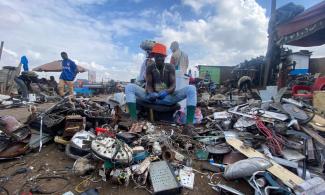On the sidelines of the 79th UN General Assembly, Health Minister Dr. Bernard Okoe Boye and Education Minister Dr. Yaw Osei Adutwum of Ghana, joined the First Lady of the United States Jill Biden, USAID Administrator Samantha Power, and UNICEF Executive Director Catherine Russell to launch a global initiative to end childhood lead poisoning in low- and middle-income countries. The Partnership for a Lead-Free Future is the first ever public-private partnership dedicated to tackling an often neglected yet solvable issue affecting one in two children in these countries. Ghana is one of 20 founding countries with over 30 other partners including philanthropies/ foundations, private sector organizations and U.S. government agencies.
Globally, lead exposure kills 1.5 million people each year – more than annual deaths from HIV and malaria combined – and the vast majority of these are in low- and middle-income countries. Lead exposure may account for as much as 20 percent of the gap in educational outcomes between high- and low-income countries and create at least a $1.4 trillion loss in global GDP each year. Lead exposure can harm the brain and nervous system, slow growth and cause learning, behavioral, hearing and speech problems. That brain damage, if severe, could also impair educational attainment and reduce future productivity.
Despite the scale of the harm caused by lead, international donors have only dedicated $15 million annually to address this problem. That changed on September 23, 2024, when members of The Partnership for a Lead-Free Future collectively committed over $150 million toward mitigating global lead exposure, including nearly $25 million that USAID will provide, in consultation with Congress.
“Lead exposure is a major public health concern, and women of reproductive age and children are particularly at risk. USAID is happy to partner with Ghana to address the negative consequences of lead exposure. This Partnership will help us create a safer, healthier future for Ghana’s children,” said USAID/Ghana Mission Director, Kimberly Rosen.
In Ghana, the primary sources of lead pollution are traditional eyeliners and cosmetics, cookware, lead-based paint, and the recycling of used lead acid batteries. A survey by the Ghana Health Service and its partners in the Greater Accra, Ashanti, and Northern Regions found that 53.5 percent of children had blood lead levels higher than the World Health Organization maximum of 5 micrograms per deciliter (μg/dL). In the Northern Region, this figure was even higher at 75 percent. These alarming statistics underscore the urgent need for action.
Ghana currently has no law specifically banning lead-based paint. However, in 2022/23, the Ghana Standards Authority, Environmental Protection Agency, Lead Exposure Elimination Project, and Environment Youth Action Network, created a lead paint standard to limit lead content in paint. The Global Alliance to Eliminate Lead Paint also helped draft a lead paint law, which is awaiting presidential approval.
Joining The Partnership for a Lead-Free Future will build on Ghana’s ongoing efforts to reduce exposure to lead poisoning in children.
The Partnership for a Lead-Free Future, with its secretariat at UNICEF, is facilitated through growing leadership of national governments. Since Administrator Power made a call to action to eliminate lead from consumer goods one year ago, six countries have already committed to regulating lead in paint for the first time.
The Partnership will marshal more global attention, leadership, and resources to champion these country-led efforts to phase out lead in consumer goods and ensure safer industrial stewardship of lead. As a first step, it will facilitate blood lead surveys and environmental testing in low- and middle-income countries to determine the source and extent of lead poisoning across the population. Based on the priority areas arising from that measurement, the Partnership will work with national governments to accelerate their efforts to implement effective regulations and standards and mobilize the private sector to transition to lead-free alternatives and lead-safe industrial operations.
The newly launched Partnership for a Lead-Free Future is open to national governments, international organizations, and philanthropies that support the Partnership mission statement, indicating commitment to making concrete efforts that reduce lead exposure.

Modern Ghana Business
